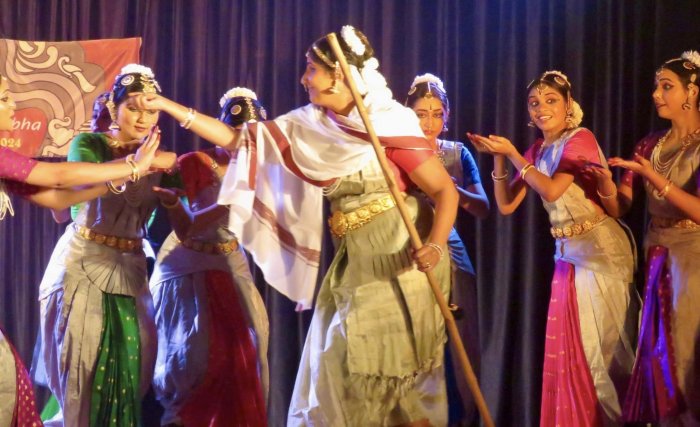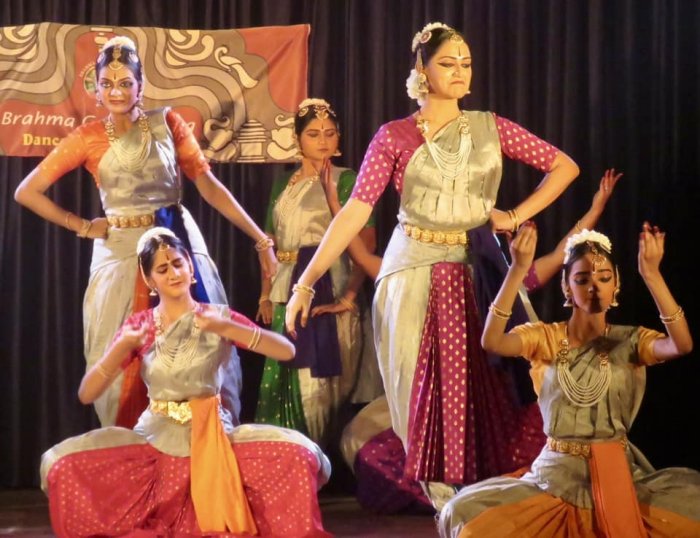
|   |

|   |
Waking-up Free: India's journey - the definition of Navarasas visually and choreographically - Saranya Devan e-mail: saranya.devan29@gmail.com January 12, 2024 It has been mentioned that Bharatanatyam is characterized by the clear classification of the Navarasas. How true this was when Lavanya Rajagopalan and Priya Murle's production Waking-up Free: India's journey treated audiences at the Bharatiya Vidya Bhavan and TAG Dakshinamurthy auditorium during the Margazhi season, to an array of colours contrasted to a completely different look with silver costumes rather than the traditional pattu sarees, through their heartwarming, soul-stirring work that was a rainbow of emotions or rasa. A smoked-up stage and moody lighting set the mood for the Todayamangalam we are introduced to which poignantly paid tribute to ancient India. As mentioned by the voiceover at the start of the production, Waking-up Free: India's journey is a "journey to obtaining India's freedom" through the format of a margam which is reflective of being "emotional and spiritual" and poignantly provides a strong narrative. This was ever so evident in the timeless Jathiswaram, which focused on the arrival of the British East India Company. The timeless classical composition from the Sree Bharatalaya repertoire had lyrics intertwined by Nirmala Jayaraman.  Photo: PS Prasad A simple costume addition of a piece of fabric, navy blue representative of the British and orange representative of the Indians, wrapped around the dancer's ottiyanam (hip belt), spelled out the two groups. What a strong piece - besides the precision of jathis that were well-executed by the dancers with their perplexing footwork, the dialogue that was exchanged between the characters was beautifully choreographed with strong gestural motifs such as the conniving of the British, the uncertainty felt by the Indians and eventually ending with a potent overruling of Indians by the British through a moving tableau aided by fluorescent lighting capturing the moment of entrapment of the Indians overruled by the demonic British. The format of the varnam emotively expressed India's struggle for freedom with snippets of history intertwined in the form of poetry. It is important to note that the depth of detail and effort put into this varnam must be commended because Rajagopalan and Murle unearthed forgotten bits of history through this work. It was so moving that each time this specific piece was performed at a different auditorium, the audience reaction was just heartwarming and was clearly felt by the performers.  Photo: AS Diwakar One could feel the compassion, hurt and pain that the dancers on stage were portraying through the vigorous jathis well-complemented with moving poetry of Subramania Bharati and Rabindranath Tagore. The non-violence movement of Gandhiji came alive, especially through the enactments made by Aishwarya Rajkumar and Lavanya Rajagopalan, with simple costume additions such as a Kashmir shawl and a 'lathi'. A very touching intersection in the varnam was Priya Murle's solo rendition of the Tamil song for peace, Saanti nilava vendum, by Sethumaadhava Rao. Murle was truly such a symbol of peace as she graced the stage, with the gleaming lighting celebrating her generous use of rasa. The duet that followed the varnam by Rajagopalan and Murle was evidence of the sweet, choreographic, friendship that these two noted artistes share. They were able to excellently balance one another. A moment that kept everyone's feet tapping was the medley that illustrated the beauty of Indian culture and its richness in holding onto religion, spirituality and traditions through use of dance forms such as Kathak and Odissi. The thillana was truly a celebration of the entire work and packaged the production's concept meaningfully and eloquently.  Photo: AS Diwakar Waking-up Free: India's journey certainly took use of the space/stage in Bharatanatyam to the next level with unusual formations. A fitting ending was the use of Vande Mataram and the different symbols of freedom seen in this choreography. Nandini Anand is to be commended for the sterling job of music composition and direction that was of high quality. Kudos to the entire team for the sterling efforts in bringing to life such a touching story in a clean and clear manner.  Saranya Devan is a PhD scholar and guest lecturer at the University of Cape Town, South Africa. |